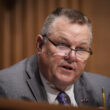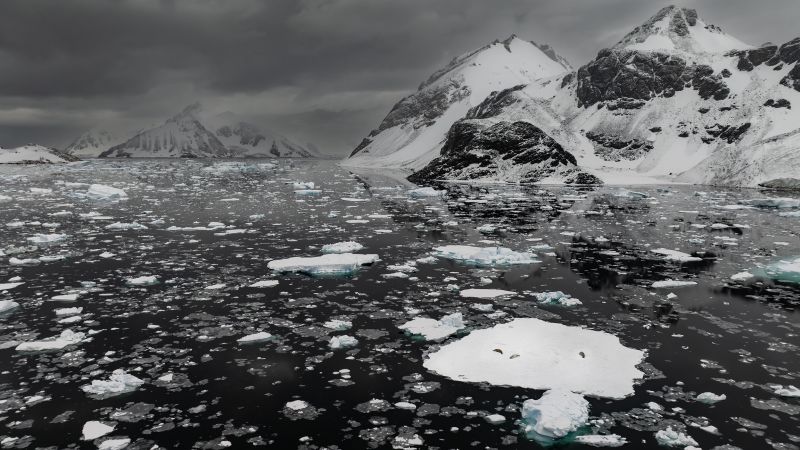CNN
—
A record-breaking heat wave unfolding at what should be the coldest time in Earth’s coldest place has scientists concerned about what it could mean for the future health of the Antarctic continent, and the consequences it could inflict for millions of people across the globe.
Temperatures since mid-July have climbed up to 50 degrees Fahrenheit above normal over parts of Antarctica and unseasonable warmth could continue through the first half of August.
The latest data shows high temperatures in portions of East Antarctica – where the most abnormal conditions are ongoing – that are typically between minus 58 and minus 76 degrees Fahrenheit are now closer to minus 13 to minus 22 degrees Fahrenheit.
That’s cold, but Bismarck, North Dakota, has reached minus 20 degrees at least once a year in almost every year since 1875. Antarctica’s typical winter cold should be operating at a level unfathomable to most people in the US.
Summerlike heat in the dead of winter – even if much of the continent is still below freezing – is an alarming development for a place more capable than any other of generating catastrophic sea level rise as fossil fuel pollution continues to drive global temperatures upward.
Most of the planet’s ice is stored here, and were it all to melt, would raise average global sea levels by well over 150 feet. Even smaller icy features, like the so-called Doomsday Glacier, could raise sea levels by 10 feet if they were to melt – catastrophic amounts for the world’s coastal communities.
It’s possible more heat waves like this will happen in future winters, which could leave the icy continent less fortified for its hottest season – summer – and more vulnerable to melting during subsequent heat waves, said David Mikolajczyk, a research meteorologist with the Antarctic Meteorological Research and Data Center at the University of Wisconsin-Madison.
Increased Antarctic melting could also potentially alter global oceanic circulations, Mikolajczyk told CNN. These circulations play an outsized role in making the planet’s climate habitable.
“I’m sure more (impacts) will emerge with time as we understand (this heat wave) better, but at the moment, it’s just a case of astonishment really, what we’re seeing,” Thomas Bracegirdle, deputy science leader for the British Antarctic Survey’s Atmosphere, Ice and Climate team, said.

Bracegirdle told CNN the temperatures in this event were record-breaking and were an important signal of what could be coming in the longer term. Heat waves of this magnitude should be quite rare in Antarctica and scientists aren’t yet certain that they are occurring more frequently, but that may be changing.
“All we can say at this stage is that more high temperature extremes are what we expect (in Antarctica) under a changing climate, but for this particular event we’ll have to study more,” Bracegirdle said.
It also contributed significantly to Earth’s new hottest day on record in late June, according to an analysis from the European Union’s Copernicus Climate Change Service.
This is the second significant heat wave Antarctica has endured in the last two years. During the previous in March 2022, temperatures in some locations reached up to 70 degrees above normal, the most extreme temperature departures ever recorded in this part of the planet.
That unprecedented heat wave was made worse by climate change, according to a 2023 study published in Geophysical Research Letters. Climate change contributed 3.6 degrees of warming to the heat wave and could worsen similar heat waves by 9 to 10.8 degrees Fahrenheit by 2100, the study found.
While the current heat wave hasn’t seen temperature departures reach the level of 2022, it’s been much more expansive and long-lasting, according to Ted Scambos, a glaciologist at the University of Colorado Boulder.
And the crucial differences between the two come down to what’s happening in the atmosphere.
‘A very unusual event’
The set of atmospheric conditions largely responsible for the ongoing heat wave – a breakdown of the southern polar vortex – is only expected to occur once every two decades on average, according to Bracegirdle.
“This is a very unusual event, from that perspective,” Bracegirdle added.
Just like the Northern Hemisphere, the Southern Hemisphere has a polar vortex – strong winds circulating high in the atmosphere that trap cold air in place.
But when the southern polar vortex gets disrupted, it releases cold air trapped over Antarctica and sends bursts of it farther north. This also leaves the door open for air to rush down from the upper atmosphere, warming along the way.
The southern polar vortex is disrupted much less frequently than its northern counterpart, which explains why such heat waves are much less frequent, according to Amy Butler, a research physicist at NOAA’s Chemical Sciences Laboratory.
This polar vortex disruption began in the second half of July and could continue through the first half of August, perhaps peaking in intensity in about a week, Butler told CNN. This will keep temperatures at the surface elevated.
At the same time, multiple surges of warm air from the southwestern Indian Ocean pushed over East Antarctica – which comprises about two-thirds of the entire continent. Each surge of warm air was followed by another so closely that the warming has been nearly continuous over the last few weeks, according to Scambos.
East Antarctica – home to the South Pole – is where the most frigid conditions on Earth are found and is typically protected from this kind of extreme warmth, according to Mikolajczyk. But that wasn’t the case in this event or in 2022’s.
It’s part of a larger trend with already measured consequences.
The South Pole warmed more than three times the global average rate from 1989 to 2018, a 2020 study published in the journal Nature Climate Change found.
West Antarctica and its Thwaites “Doomsday” Glacier have been a major focus of scientific research in recent years due to the catastrophic impact its collapse would have on sea level rise. But other research in the last few years has demonstrated that melting in East Antarctica, where this heat wave is happening, is becoming equally troubling.
The recent warmth has posed a significant problem to the continent’s crucial ice sheet. Antarctica lost a staggering 280% more ice mass in the 2000s and 2010s than it lost in the 1980s and 1990s, according to a 2019 study published in the Proceedings of the National Academy of Sciences.
“In recent years, I would say that the feeling was that the Arctic is the place where all the rapid change is happening and (change) was happening quite slowly in Antarctica,” Mikolajczyk mused. “But this is just another event that’s showing (change) can also happen quickly in Antarctica.”













